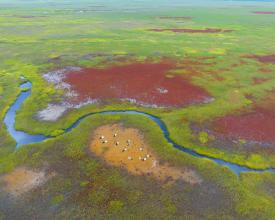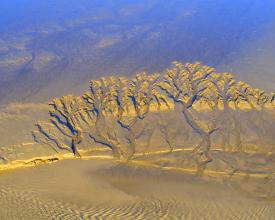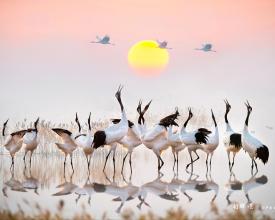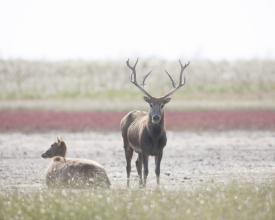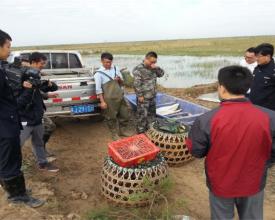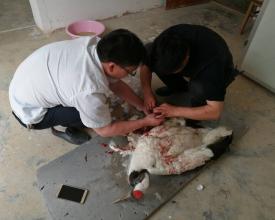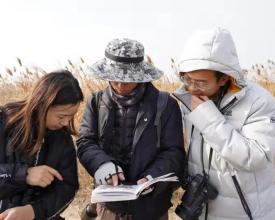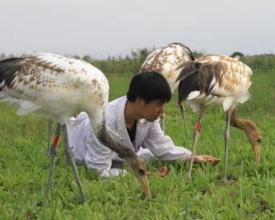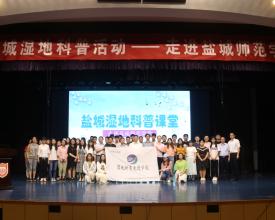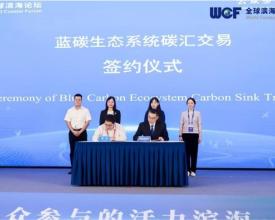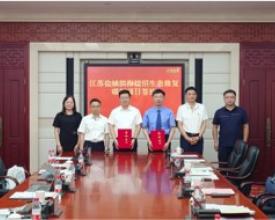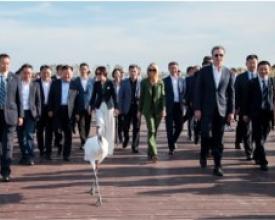Management and Protection of the Coastal Wetlands in Yancheng, China
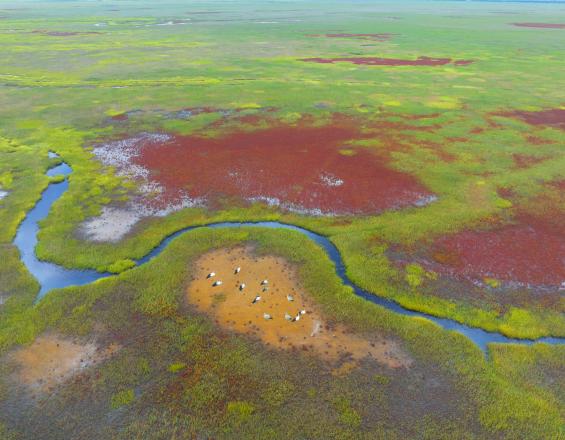
The Jiangsu Yancheng Wetland Rare Birds National Nature Reserve has the largest and most intact intertidal ecosystem on the western coast of the Pacific and the eastern edge of the Eurasian continent. It serves as an important stopover for water birds on the East Asian-Australasian Flyway and protects the largest wild red-crowned crane wintering population in China. Over the past 40 years, the reserve has carried out extensive work in coastal wetland and wildlife protection, scientific monitoring and research, publicity and nature education, and the transformation of the value of ecological products. It has continuously improved its construction and management level, made unremitting efforts in the practice and demonstration of protection, development, and support functions, and effectively protected the biological and cultural diversity within the area. It plays an important role in maintaining ecological security and showcasing ecological image.
Context
Challenges addressed
The Jiangsu Yancheng Wetland Rare Birds National Nature Reserve is 2,473 square kilometers. In recent years, the tidal flats in the north buffer zone and core area of the reserve have frequently suffered from erosion. The outer edge of the land has significantly retreated towards the land. The original foraging grounds for birds, which were mainly composed of bare mudflats and tidal channels, as well as the breeding and resting grounds for birds represented by Suaeda and Zoysia meadows, are all significantly decreasing.
Due to historical reasons, there were some community units and residents in the buffer zone and experimental zone of the reserve when it was established. The ecological space and the space for production and living are squeezing each other. The contradictions between protection and development are still prominent. The mechanism for coordinating community interests is not yet perfect.
Location
Process
Summary of the process
The nature reserve has strengthened the modernization of the governance system and capabilities of the wetland ecosystem as a starting point, effectively protecting the authenticity and integrity of the Yancheng Yellow Sea Wetland ecosystem. For example, by enhancing collaborative supervision with local governments, establishing a “one center, four systems” management and protection model, and carrying out wetland restoration, the safety barrier of the wetland ecosystem has been effectively consolidated. By enhancing scientific research cooperation and exchanges, breaking through key scientific research technologies, and innovatively conducting wetland popular science publicity and education, the function of scientific research and publicity in supporting protection has been continuously played. By establishing community liaison meeting mechanisms and exploring pathways for the realization of the value of ecological products, a foundation has been laid for the community’s green transformation and sustainable development.
The above-mentioned measures have provided a replicable model for the development of nature reserves in the Yangtze River Delta region, which is economically developed, densely populated, and rich in wetland resources in East China.
Building Blocks
Wetland Conservation: Prioritize protection and build a solid safety barrier for wetlands.
- Explore and promote a coordinated supervision mechanism for the reserve. Establish a quadruple linkage mechanism with local ecological environment and natural resources departments, and sign a cooperation framework agreement on the supervision and management of ecological environment in nature reserves. Taking ecological environment protection supervision, the “Green Shield” special operation, and satellite remote sensing verification as the main tools, regularly carry out joint inspection special operations on prominent environmental issues in the reserve to lay a foundation for effective management and protection of the reserve.
- Explore and establish a "one center, four systems" management and protection model. That is, with the "modernization of the governance system and governance capacity for ecological civilization construction" as the core, create a "three zones" comprehensive management and protection system, an "air-sea-land" all-round management and protection system, a "24-hour" round-the-clock management and protection system, and a community grid-based full coverage co-governance system. This forms a closed management of the core area, with local governments in the buffer and experimental zones being responsible for their territories, functional departments working together to manage and protect, and community residents widely participating in a "large-scale protection" pattern.
- Explore and implement minimal intervention ecological restoration technologies. Conduct habitat reconstruction, targeting degraded wetlands, by adopting a combination of measures such as "cattail and iris crushing + micro-terrain shaping + ecological water replenishment" to reshape shallow banks, water areas, and vegetation belts suitable for foraging and resting of red-crowned cranes, and restore the hydrological connectivity of wetlands. Implement food chain restoration by introducing benthic organisms (such as snails and shellfish) to rebuild the foundation of the food chain, attracting shorebirds like sandpipers and ducks, and forming a virtuous ecological cycle. The Spartina alterniflora control project has been implemented, using methods such as mowing, deep turning, and flooding, with more than 70,000 acres of Spartina alterniflora controlled. The treated areas have become new habitats for red-crowned cranes and other rare birds.
Enabling factors
- The correct leadership of the higher-level governments and departments
- The broad basis for cooperation among governments at all levels.
- Nature-based Solutions
Lesson learned
- The contradiction between protection and development still exists.
- The impacts of global climate change and human development on coastal wetlands are constantly changing, posing significant challenges.
- There is a lack of long-term and effective mechanisms for cross-regional coordinated protection.
Scientific Research and Monitoring: Enhance cooperation and exchanges, and strengthen the support for scientific research and publicity education.
- Establish a scientific research and monitoring system. Utilize technologies such as satellite tracking, drone patrols, and bird banding, in conjunction with hydrological, soil, and meteorological data, to construct an integrated monitoring system for "resources - environment - geology and geomorphology." Persist in conducting uninterrupted synchronous surveys of wintering waterbirds for 40 years, promote routine monitoring of wildlife and their habitats, and continue to monitor environmental factors, sources of diseases, invasive alien species, and changes in coastal sedimentation and erosion.
- Establish a system for artificial breeding and wild release technology. Since Xu Xiujun pioneered artificial incubation technology in 1986, the reserve has established a mature red-crowned crane artificial breeding system, including temperature and humidity control, chick rearing supervision, etc. By 2024, the cumulative number of artificially bred red-crowned cranes has reached 300.
- The popular science and education brand system is gradually being perfected. It has formed live broadcast brands such as "Red-crowned Cranes Coming Home for the New Year," activity brands like "Little Crane Classroom," competition brands such as "Youth Bird Identification Skills Competition," and course brands like "Notes from Nature." A nature education and research model led by the reserve, with nature education institutions as the main body and extensive community participation, has been successfully established.
Enabling factors
- A solid foundation for scientific research cooperation.
- The long-term accumulated results of scientific research and monitoring.
- The advanced Internet and information technology have helped the nature reserve make great progress in popular science publicity and education.
Lesson learned
- A multi-disciplinary coordinated scientific research system has not yet been formed.
- There are bottlenecks in the innovation of forms, methods, and interactions in popular science publicity and education.
Community Co-construction: Focus on Green Development and Promote Community Co-governance and Shared Benefits
- Advocate the establishment of a joint meeting system for management. Take the lead in convening joint meetings on nature reserve management, and sign management target responsibility agreements for the rare bird reserve with the local government.
- Take the lead in establishing the Yancheng Yellow Sea Wetland Ecological Agriculture Industry Promotion Association, fully play the bridging and linking role of social organizations, strengthen joint efforts and collaboration, and promote the green transformation of a number of traditional planting and breeding projects.
- Conduct ecotourism activities. The reserve has been built into a national AAAA-level scenic area and a nature education base, with more than 4 million visitors received in total, promoting the integration of ecological protection and public education.
- Conduct coastal blue carbon research. Jointly carry out research on the role of salt marsh wetlands in carbon sequestration, biodiversity conservation, and community economic development with relevant institutions. Complete two salt marsh blue carbon transactions, providing examples for exploring the value realization of salt marsh ecosystems.
Enabling factors
- The concept of ecological civilization has been widely disseminated and recognized.
- Strong support from local governments for the development of ecotourism.
- Policy support for carbon sink development and trading.
Lesson learned
A minority of stakeholders lack sufficient awareness of ecological protection and sometimes prefer to sacrifice the ecological environment for economic benefits.
Impacts
Through unremitting efforts, the nature reserve has made great progress in protection, support, and development. Biodiversity in the reserve has significantly increased, with the number of bird species rising to 425. The artificial breeding population of red-crowned cranes has steadily grown, with 60 artificially bred red-crowned cranes in 2024, bringing the total number to over 300. The wetland ecosystem has remained stable, with more than 30,000 acres of functionally degraded wetlands restored and over 70,000 acres of the invasive species Spartina alterniflora removed. In the ecologically restored areas, the number of birds such as red-crowned cranes and oriental white storks has significantly increased. Eighty-eight local community residents have been employed by the reserve as wetland rangers or engaged in tourism-related work, while 26 have voluntarily become community patrol volunteers. Ecotourism has flourished, with the number of visitors increasing by 150% from 2015 to 2024.
Beneficiaries
Local governments at all levels
Jiangsu Yancheng National Nature Reserve for Wetland Rare Birds
Surrounding communities
Local residents
The general public
Research institutions
NGOs
Tourism and research institutions
Global Biodiversity Framework (GBF)
Sustainable Development Goals
Story
In the Jiangsu Yancheng National Nature Reserve for Rare Birds, there is a true story that has been passed down. It tells of a beautiful 23-year-old girl who, with a life as brilliant as a summer flower and a death as serene as an autumn leaf, demonstrated the loftiness of spirit and the value of life. She dedicated her short but great life to the cause of ecological protection she fought for.
Xu Xiujun was born on October 22, 1964, in Qiqihar City, Heilongjiang Province. In August 1981, she became a crane keeper at the Zhalong Nature Reserve, also becoming the first crane girl in China. In March 1985, she self-funded her studies at the Wildlife Department of Northeast Forestry University and successfully completed her studies. In May 1986, she was invited by the Yancheng Nature Reserve to bring three crane eggs to Yancheng in the south, where she successfully established the first red-crowned crane breeding farm in southern China. On September 16, 1987, she tragically drowned while searching for two lost swans. Her life was forever frozen at the young age of 23, and she interpreted a true story with love and dedication. In July 1989, she was posthumously awarded the title of "Revolutionary Martyr" by the Ministry of Civil Affairs of China.
When the news of Xu Xiujun's passing reached the other side of the ocean, Dr. George Archibald, chairman of the International Crane Foundation, wrote to Xu Xiujun's father, Xu Tielin, and enclosed two photos he had taken of her in Zhalong. In his letter, he wrote: "I will never forget the wonderful work done by your beloved daughter. Every time I look at the cranes in the sky, I always think of her soul that has gained freedom. I believe the photos I am sending will bring back wonderful memories of this extraordinary woman."
